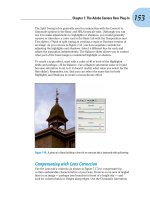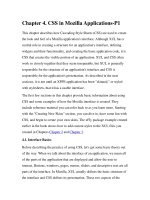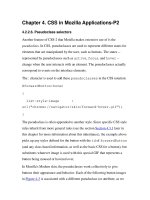Chapter 4 v7 01 accessible
Bạn đang xem bản rút gọn của tài liệu. Xem và tải ngay bản đầy đủ của tài liệu tại đây (2.06 MB, 78 trang )
Computer Networking: A Top Down
Approach
Seventh Edition
Chapter 4
The Network Layer: Data
Plane
Slides in this presentation contain
hyperlinks. JAWS users should be able to
get a list of links by using INSERT+F7
Copyright © 2017, 2013, 2010 Pearson Education, Inc. All Rights Reserved
Learning Objectives (1 of 7)
4.1 Overview of Network layer
– data plane
– control plane
4.2 What’s inside a router
4.3 IP: Internet Protocol
– datagram format
– fragmentation
– IPv4 addressing
– network address
translation
– IPv6
4.4 Generalized Forward
and SDN
– match
– action
– OpenFlow
– examples of matchplus-action in action
Copyright © 2017, 2013, 2010 Pearson Education, Inc. All Rights Reserved
Chapter 4: Network Layer
chapter goals:
• understand principles behind network layer services,
focusing on data plane:
– network layer service models
– forwarding versus routing
– how a router works
– generalized forwarding
• instantiation, implementation in the Internet
Copyright © 2017, 2013, 2010 Pearson Education, Inc. All Rights Reserved
Network Layer
• transport segment from
sending to receiving host
• on sending side
encapsulates segments
into datagrams
• on receiving side, delivers
segments to transport layer
• network layer protocols in
every host, router
• router examines header
fields in all IP datagrams
passing through it
Copyright © 2017, 2013, 2010 Pearson Education, Inc. All Rights Reserved
Two Key Network-Layer Functions
network-layer functions:
• forwarding: move packets from router’s input to appropriate
router output
• routing: determine route taken by packets from source to
destination
– routing algorithms
analogy: taking a trip
• forwarding: process of getting through single interchange
• routing: process of planning trip from source to destination
Copyright © 2017, 2013, 2010 Pearson Education, Inc. All Rights Reserved
Network Layer: Data Plane, Control
Plane
Data plane
Control plane
• local, per-router function
• network-wide logic
• determines how datagram arriving
on router input port is forwarded to
router output port
• determines how datagram is
routed among routers along endend path from source host to
destination host
• forwarding function
• two control-plane approaches:
– traditional routing
algorithms: implemented in
routers
– software-defined
networking (SDN):
implemented in (remote)
servers
Copyright © 2017, 2013, 2010 Pearson Education, Inc. All Rights Reserved
Per-Router Control Plane
Individual routing algorithm components in each and every
router interact in the control plane
Copyright © 2017, 2013, 2010 Pearson Education, Inc. All Rights Reserved
Logically Centralized Control Plane
A distinct (typically remote) controller interacts with local
control agents (CAs)
Copyright © 2017, 2013, 2010 Pearson Education, Inc. All Rights Reserved
Network Service Model
Q: What service model for “channel” transporting datagrams
from sender to receiver?
example services for individual datagrams:
• guaranteed delivery
• guaranteed delivery with less than 40 msec delay
example services for a flow of datagrams:
• in-order datagram delivery
• guaranteed minimum bandwidth to flow
ã restrictions on changes in inter-packet spacing
Copyright â 2017, 2013, 2010 Pearson Education, Inc. All Rights Reserved
Network Layer Service Models:
Network
Architecture
Service
Model
Guarantees ?
Bandwidth
Guarantees ?
Loss
Guarantees ?
Order
Guarantees ?
Timing
Congestion
feedback
best effort
none
no
no
no
no (inferred
via loss)
A TM
CB R
constant
rate
yes
yes
yes
no
congestion
A TM
VBR
guaranteed
rate
yes
yes
yes
no
congestion
A TM
ABR
guaranteed
minimum
no
yes
no
yes
A TM
UB R
none
no
yes
no
no
Internet
Copyright © 2017, 2013, 2010 Pearson Education, Inc. All Rights Reserved
Learning Objectives (2 of 7)
4.1 Overview of Network layer
– data plane
– control plane
4.2 What’s inside a router
4.3 IP: Internet Protocol
– datagram format
– fragmentation
– IPv4 addressing
– network address
translation
– IPv6
4.4 Generalized Forward
and SDN
– match
– action
– OpenFlow
examples of matchplus-action in action
Copyright © 2017, 2013, 2010 Pearson Education, Inc. All Rights Reserved
Router Architecture Overview
ã high-level view of generic router architecture:
Copyright â 2017, 2013, 2010 Pearson Education, Inc. All Rights Reserved
Input Port Functions (1 of 2)
Copyright © 2017, 2013, 2010 Pearson Education, Inc. All Rights Reserved
Input Port Functions (2 of 2)
Copyright © 2017, 2013, 2010 Pearson Education, Inc. All Rights Reserved
Destination-Based Forwarding
Q: but what happens if ranges don’t divide up so nicely?
Copyright © 2017, 2013, 2010 Pearson Education, Inc. All Rights Reserved
Longest Prefix Matching (1 of 2)
longest prefix matching
when looking for forwarding table entry for given destination
address, use longest address prefix that matches destination
address.
examples:
Copyright © 2017, 2013, 2010 Pearson Education, Inc. All Rights Reserved
Longest Prefix Matching (2 of 2)
• we’ll see why longest prefix matching is used shortly,
when we study addressing
• longest prefix matching: often performed using ternary
content addressable memories (TCAMs)
– content addressable: present address to TCAM :
retrieve address in one clock cycle, regardless of
table size
– Cisco Catalyst: can up ~1M routing table entries in
T CAM
Copyright © 2017, 2013, 2010 Pearson Education, Inc. All Rights Reserved
Switching Fabrics
• transfer packet from input buffer to appropriate output buffer
• switching rate: rate at which packets can be transfer from inputs to outputs
– often measured as multiple of input/output line rate
– N inputs: switching rate N times line rate desirable
ã three types of switching fabrics
Copyright â 2017, 2013, 2010 Pearson Education, Inc. All Rights Reserved
Switching via Memory
first generation routers:
• traditional computers with switching under direct control of
CPU
• packet copied to system’s memory
• speed limited by memory bandwidth (2 bus crossings per
datagram)
Copyright © 2017, 2013, 2010 Pearson Education, Inc. All Rights Reserved
Switching via a Bus
• datagram from input port
memory to output port memory
via a shared bus
• bus contention: switching
speed limited by bus bandwidth
• 32 Gbps bus, Cisco 5600:
sufficient speed for access and
enterprise routers
Copyright © 2017, 2013, 2010 Pearson Education, Inc. All Rights Reserved









